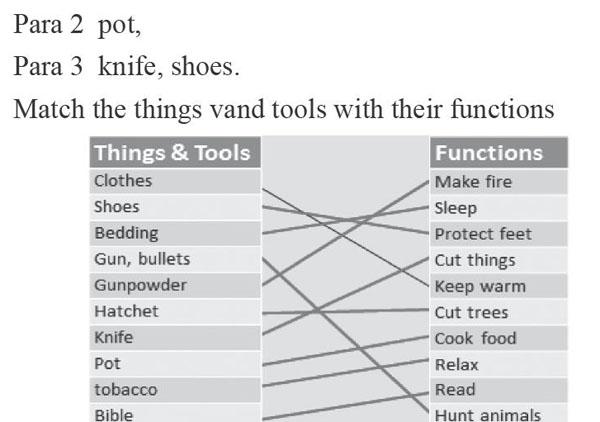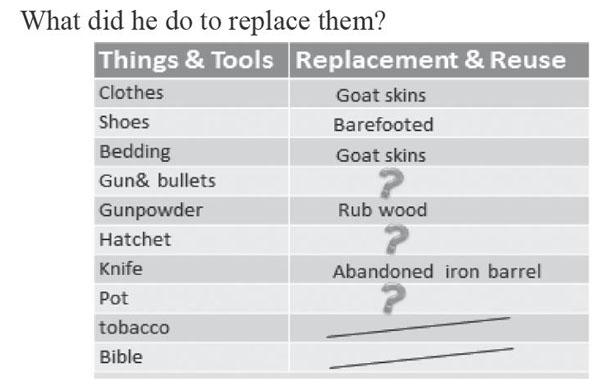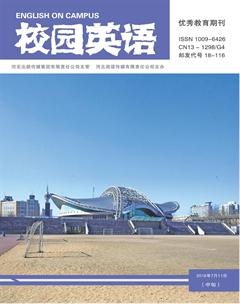基于智慧教室的中职英语互动式阅读教学课例分析
金洁
【摘要】本文旨在探讨基于智慧教室的中职英语阅读课互动式教学设计和课例分析,教师在充分利用智慧教室的软硬件配置的基础上,将信息技术与中职英语课程深度整合,让学生在步步推进的教学过程中,始终保持足够的积极性和专注度参与到阅读过程中。学生在图文并茂、人机交互、即时反馈的英语学习环境中,通过小组合作学习探究、模拟求生演练、在线课堂评价等教学手段,实现互动式阅读功能。学生发挥主动性和自主性,真正在“做中学”,成为课堂的主体。
【关键词】智慧教室 中职英语阅读课 互动式教学
一、研究背景
信息技术与学科整合一直是教学上的热点。信息技术应用教学的变革历程:由最初扫电脑盲开始,提倡人人课堂使用PPT 教学,发展到基于跨越式课题进行网络班教学,再发展到电子白板课堂普及使用,现迎来了人手一台教育pad的“智慧教室”年代。2015年江阴中等专业学校正式引进智慧教室Hiteach教学系统和Irs反馈系统,进入一个信息化教学的新的台阶。
二、智慧教室的定义
智慧教室的定义为:在云技术环境下,“智慧”体现学习者在学习过程中实时反馈及检测学生的学习进度,并能进行智能分析、智能判断学生学习状态,然后根据学生学习状态进行资源推送,进行分层学习或个性化学习,此时所需的资源为微课、课件、不同层次的题库等大量的云资源。因此,智慧教室在硬件设备上需要高端技术的支持,必须配置交互式智能一体机、录播系统、应答系统、教育云平台以及人手一台平板电脑。云技术环境下的智慧教室有利于互动式学习,它提供教师能获得更快速的学生学习信息反馈的评测工具,促使教师真正实现关注差异,因材施教。根据知识建构的三个层次(知识的系统建构、知识的意义建构、知识的协作建构),教师引导学生在课堂上进行个性化的自主学习。这与传统教育模式中职学生的被动授课的学习有着本质的区别。依托“智慧教室”的学习是主动的,而学习资源更为丰富有趣。学生按个人所需,平台按需输送学习的信息或解决问题和探讨问题的方式,基于学生认知的初始水平,以学生的知识和能力的发展为目标的个性化学习过程。
三、“智慧教室”下互动式阅读教学模式的探索
课例选自江苏省职业学校文化课教材配套教学用书《英语》第六册第二单元中的Reading阅读课Life on a Desert Island,授课班级为13级机电五年制大专班的学生。在智慧教室Hiteach授课环境下,教师充分利用智慧教室的软硬件配置,将信息技术与英语阅读课程深度整合,发挥智慧教室的优势,运用信息技术为学生创造出图文并茂、人机交互、即时反馈的英语学习环境,通过小组合作学习探究、模拟求生演练、在线课堂评价等教学手段,学生积极性被充分调动。学生发挥主动性和自主性,真正在“做中学”,成为课堂的主体。下面将本节课基于智慧教室下的互动式教学设计总结如下:
Quiz
Qs: 1. Why was Alexander Selkirk stuck on the island? (A)
A. He guessed his ship would sink and chose to leave before it really happened.
B. He wanted to prove that he could live on the island on his own.
C. His ship sank and he swam to the island.
2. How long did Alexander Selkirk live on the island? (B)
A. About 10 years.
B. About 5 years.
C. About 16 years.
3. Who wrote the book Robinson Crusoe? (A)
A. Daniel Defoe
B. Alexander Selkirk
C. Robinson
Lead-in
A picture of an island is shown to students.
Ask them: Is it beautiful? Do you want to live there, but with no one around you? Can you imagine if you were stuck on the island, what would you bring?
Watch a micro-video made by some of the students.
After that, ask them:
Who do you think made the smarter choice, Jiang or Wang? Wang.
What would Wang bring? A bottle of water and a knife.
Who does he learn from? Bear Grylls.
With the experience learned from Bear Grylls, students must be ready to go on an adventure with Alexander Selkirk.
Listen to the tape on the platform and circle the things and tools that Alexander Selkirk brought from the ship. Students do it on their own pads.
Para1 Clothes, bedding, gun, gunpowder, bullets, tobacco, hatchet, Bible,
Para 2 pot,
Para 3 knife, shoes.
Match the things vand tools with their functions
Replacement& Reuse
When time passed by, the things and tools that he brought from the ship gradually wore out.
What are the things and tools that gradually wore out mentioned in the text? Clothes, shoes, bedding, gunpowder, knife.
What did he do to replace them?
How to replace gun and bullets, hatchet and pot?
Work in groups. Students can search online or watch videos uploaded onto the QQ group.
Students offer different ideas.
We can find food by catching fish, making a trap…
We can use a sharp stone tied onto a piece of wood to make a hatchet.
We can barbeque, cook food in a coconut or on hot stones, eat raw food…
Summarize the text by filling in the blanks.
Interview
Watch a video. Then ask them:
Was he brave? Yes!
Why did not he give up? Because he wanted to go home alive.
Finally he did it and was rescued by a passing-by ship. Suppose Alexander Selkirk were invited to our class, students mast have a lot of questions to ask him. Prepare for the interview. Students can practice asking and answering with group members.
Ask one student to play the role of Alexander, and the other students can ask him questions freely.
Part 3: Challenge
Recently the shocking news that some young travelers put their lives in danger while hiking in the mountain make students think it necessary for them to practice survival skills.
There are four bags full of stuff that may help students. Each bag has a mission card in. Each group should work together to complete the mission. Then compete to see which group is the first to finish.
Then each group should come to the front to show their results.
Mission 1:Make a fish trap
Mission 2: Make a water filter
Mission 3: Three ways of tying a knot
Mission 4: Send signals for rescue
Part 4: Presentation
Show students some of their creative works.
Students vote for their favorite.
Share with them some achievements that senior students made.
Part 5: Assignment
Must-do:
Write a composition
If I were stuck ___________________________, how could I survive?
Write a composition of 100 words on the topic. You can choose from
in the forest, in the desert, in the snow mountain
Send your writings to e-mail 33380949@qq.com
Alternative:
Follow me on the Wechat platform and do some supplementary reading.
Part 6: Real-time Assessment
Students log onto the message board and leave some messages or make comments freely.
四、智慧教育的未来
展望未来,融合新技术的支持,无论是在教育管理、教学过程、教学工具、学习方法、校园生活等方面,在智慧教育技术的帮助下,整个校园都充满着智慧。教师所需要的教学素材,智慧系统主动给予选择,资源范围更加广泛。教学活动更加有效风趣,通过大数据平台将会更加了解学生的真实情况,为教师制定针对性的教学提供意见帮助。学生的学习在大数据智慧平台的帮助下,学习过程更加有趣,智慧系统能够感知学生最有效的学习是什么,控制学习过程,评价学习成果。教育管理者通过智慧教育大数据平台的教师教学质量分析、群体优良率分析、学生班级发展评价分析,及时了解教育水平,有效提升智慧教育的卓越绩效。这样的教育完全颠覆了我们现在的模式,展现的是另外一种革新景象,可以说这就是我们的智慧教育。

